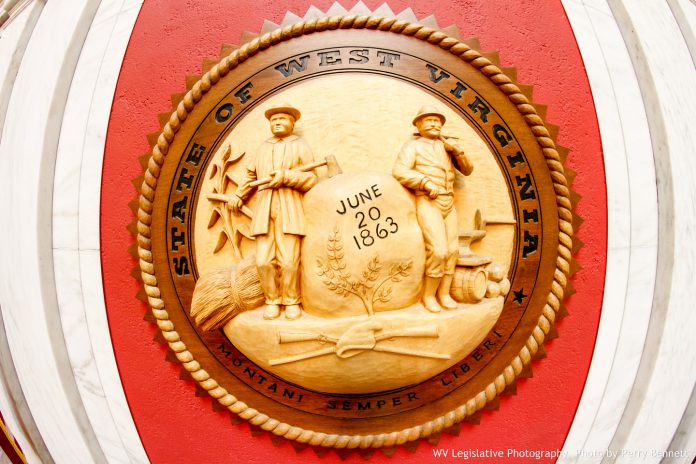
The West Virginia State Seal symbolizes the history and foundation of our state. West Virginia entered into the Union on June 20, 1863, and shortly after, on September 26, 1863, the Legislature adopted the joint resolution that made the state seal official.
The Great Seal of West Virginia promotes the state’s natural resources, economic potential and the resolve of its people through the symbols. The front, or obverse, side of the seal is centered around a large boulder meant to symbolize the strength, steadfastness and stability of the state and its citizens. Etched in the stone is the date “June 20, 1863” and in front of the boulder are two hunter’s rifles with a Phrygian cap, or cap of liberty, resting at the cross of the rifles. The liberty cap is also featured on the state seals of New Jersey and New York, as well as the official seals of the U.S. Army and United States Senate.
There are two men on either side of the boulder, each representing an important facet of the state’s economy. A farmer, promoting agriculture, stands with his ax and plow before a cornstalk while a miner, personifying industry, shoulders his pickax before an anvil and sledgehammer.
Bordering the Great Seal, the words “State of West Virginia” and the state’s motto “Montani Semper Liberi”, a Latin phrase meaning “Mountaineers Always Free”, express the independent spirit inherent in all West Virginians.
The reverse side of the state seal serves as the Governor’s Official Seal. The seal has a wreath border composed of laurel and oak leaves, signifying valor and strength as well as fruits and grains, which are prominent agricultural products of the state.
Presiding over the pastoral vista of wooded hillsides and farm animals below, the words “Libertas E Fidelitate” (Freedom and Loyalty) recall our state motto while imbuing the scene with a sense of pride and accomplishment represented by the artist’s rendering of the Baltimore and Ohio Railroad, one of the greatest engineering triumphs of its day.
The man behind the seal is Joseph H. Diss Debar, a French native who became an influential pioneer for the state of West Virginia. Diss Debar was born on March 6, 1820, in Strasbourg, France. He came to the United States in 1842 and moved to Parkersburg, WV, in 1846 to work as a land agent. Diss Debar resided in Parkersburg and St. Clara, a Doddridge County Swiss-German immigrant colony he founded and named for his wife, Clara Levassor.
Shortly after achieving statehood, West Virginia’s first Legislature created a committee to oversee the formation of a state seal. Peter G. Van Winkle, head of the committee, appointed Diss Debar to prepare drawings for an official seal for the state. Diss Debar submitted a variety of drawings and sketches accompanied with explanations of each to the Legislature. From these drawings, the House of Delegates approved the concept with only a few changes on September 23, 1863, and three days later the Senate approved what is now the Great Seal of West Virginia.
Diss Debar continued working in state government by representing Doddridge County as a member of the House of Delegates in 1864. That same year he was appointed by Governor Arthur Boreman to serve as the first Commissioner of Immigration, where he worked to recruit labor and landowners from abroad.
Joseph Diss Debar died on January 13, 1905, at the age of 84 in Philadelphia. However, his imprint remains through the proliferation of his contribution prominently displayed on all official state documents, both legislative chambers and the state flag.

